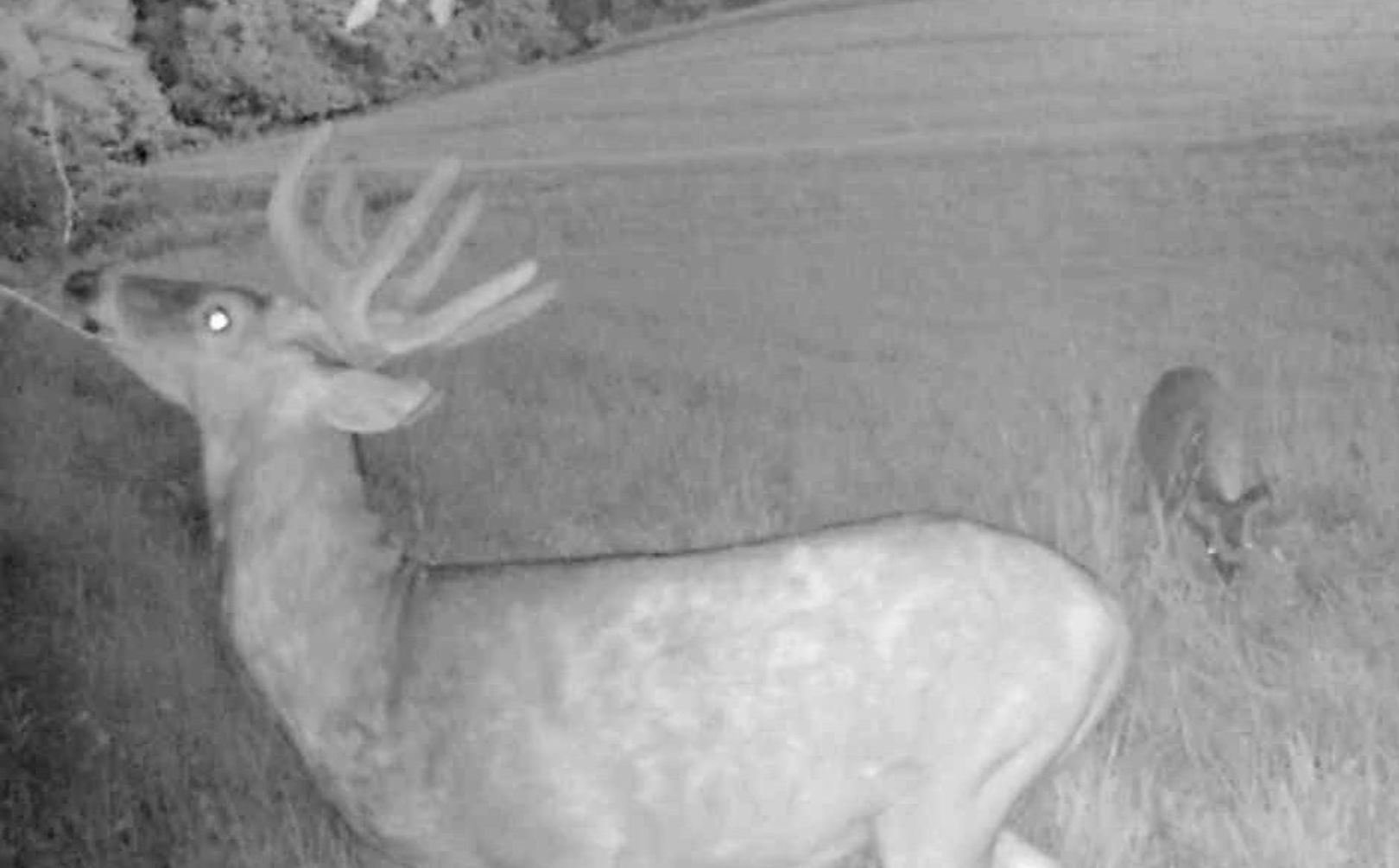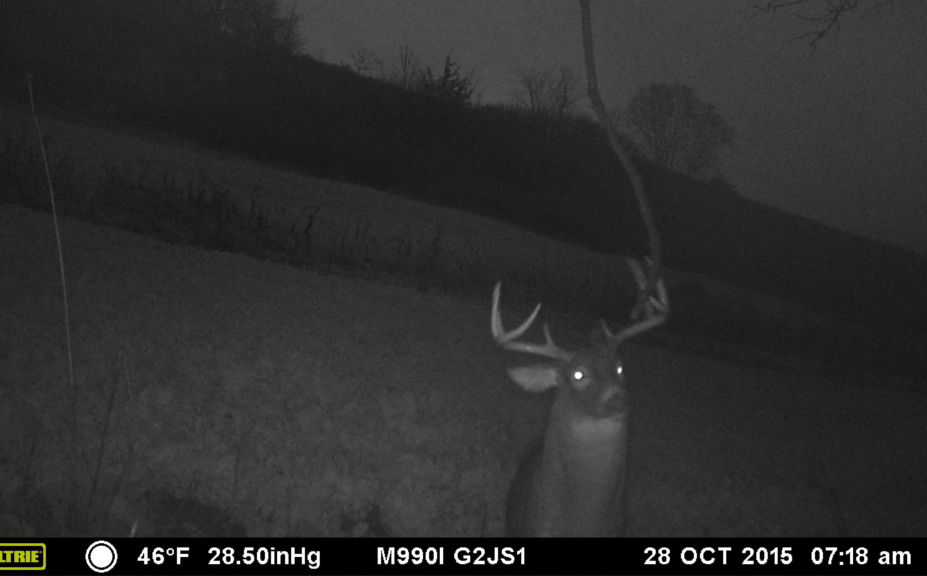
The Annual Habitat Shift Is Near
Buck-Filled fields of green dot the landscape of Mid-western habitats, and fuel the dreams of hunting seasons soon to come. But, how realistic are those dreams? In the coming weeks a giant Whitetail Shift will occur in the deer world! Both food, and cover, willchange drastically and along with that change a major shift takes place in where a mature buck calls home. During the Summer months a mature buck carries out a lazy existence often shared with a few of his buddies. He wants for nothing because abundant quality forages exist at virtually every turn to fill his fat belly, and adjacent shaded high-overstory woodlots keep him comfortable and cool during the heat of the day. He is safe, fat, cool, and happy! However, as the weeks tick by, and green woodlots turn into a rainbow of Autumn's brilliance, a mature buck's needs are ever changing.
As summer sheds her warm green coat, tender soybeans fade to brown, alfalfa turns yellow with the first frost, and hunting pressure fills the woods. The comfort of the cool, high-overstory hardwoods is now naked and exposed, leaving a mature buck to seek the security and warmth of higher stem count areas such as upland mixes of shrubs, conifer, and grasses. "Those mature bucks really turn nocturnal in October" is the common theme to explain the ominous October Lull that takes place annually. However, I have found something completely different taking place in the whitetail world, each and every year-the Whitetail Shift! A mature buck needs a completely different set of habitat conditions from when the hunting season is just beginning, and continuing as time inches closer to Winter's harsh embrace. . Most often a great place to find mature bucks during the Summer months, is also a sure-fire sign of where notto find a mature buck during the months of hunting season. Although some of those mature bucks restrict the majority of their movements until right after dark; the more common occurrence than unending nocturnal-ness, is that those bucks have shifted a mile or more to their Hunting Season Habitat. During the pre-rut and rut they may venture back to their summer ranges and occasionally fall victim to a well-placed arrow, but for the guys that key on building a parcel of Hunting Season Habitat-that's where all the fun can be found!

*The Annual Whitetail Habitat Shift as well as many other advanced mature buck hunting strategies, are covered in my 3rd Whitetail Success By Design book series,"Mature Buck Success by Design", which details how to scout, prepare, forecast for and consistently kill mature bucks.
It is not uncommon for a mature buck to travel a distance of a mile or more between his Summer and Fall range. I have personally been involved in the harvest of mature bucks that had almost completely vacated their Summer ranges of almost 2 miles away. Undoubtably the summer landowners thought that a particular 4-8 year old monster had gone completely nocturnal, when he was actually being seen, hunted, and often killed several parcels away. This year I am watching some of our own parcel giants from last year...between 3/4 and almost 1.5 miles away from where they will spend the bulk of their hunting season months. Beans and Hay seem to be the common hang-outs for right now, and there is no need at all to panic that none have shown up on the cameras yet. The Summer to Fall shift is taking place soon...and are you ready for it?
One of the great things to know about the whitetail shift is that during the rut, and especially the later 1/2 of the rut, you have a good chance of catching that mature buck who left your parcel earlier for better Fall habitat. He will may get kicked around by another more dominant buck in his preferred Fall range, careless hunters may motivate him to leave, or he will feel he has exhausted his own estrus does and go look for one last doe towards the end of the rut. The best way to kill those "prodigal sons" is in the morning, many times as they are leaving your parcel to go back to preferred Fall habitat. That's where the cameras come in...they should at least give you a direction to where his daytime bedding cover is. Figure for a very rough guide, a 1/4 mile for every hour he consistently shows up, on average...from 2 hours after dark and through the night; in particular in late September until mid-October. Use that experience as a guide for both how far he is coming from, and who's parcel he coming from.
Any important "Shift" question to ask is, "Why?"...THAT is the most important aspect of all of this because if you own private land you can change the conditions. If you hunt public land...you just need to go find the conditions for improved Fall habitat, including: Safe adequate fall food plantings such as Layered Food Plots, safe adequate fall cover (doesn't have to be the best) and reduced hunting pressure. One of my jobs as a whitetail habitat and hunting designer is to figure out WHEN, if at any time, mature bucks are on your parcel during the hunting season. I like playing detective on my client parcels and each parcel is an opportunity to be a detective in many ways:
1. Bucks mostly rub at 2 periods of time...
Early to mid Sept, and during the pre-rut/rut. Think of it this way...pre-leaf drop, and post leaf drop. also, early rubs are very aggressive on young trees...later very aggressive on larger diameter trees. But, bottom line if all of your rubs have shreddings on top of the leaves...it was post leaf drop and it tells a tale.
2. If you have lots of early rubs...
But only scattered and obvious rubline rubs of mature bucks, then you have either a cover problem, Fall food problem, or both. And don't forget about a hunting pressure problem, which can have more of an effect than either food, or cover. Clusters of sept/Oct/Nov mature buck rubs in obvious bedding areas that indicate a very good amount of time mature bucks are on your parcel...but that is very hard to do even on the best of parcels. Instead, look to collect Oct/Nov/Dec rubs and if they are there in the late Summer GREAT...if not, no big deal. Remember...the guy who holds the Summer bucks has very little influence on the overall biological make-up of the herd. Where those bucks daytime bed, eat and ultimately live or die during the hunting season is key.

*The buck featured in this article, nicknamed "Diego", is now a 5 year old bruiser that I have had 3 years of history with. We have been utilizing DeerLab to learn his habits and core area, and plan to use that information to harvest him this fall! You can try DeerLab for free by clicking right here!
3. Game cam pics are HUGE!
If you aren't using them, you are missing critical pieces of the puzzle that directly effect your overall success. They will tell you if the bucks are on your parcel early...if they come back, they will tell you what bedding area which mature buck is using, how far he is coming from your parcel, which direction he enters and exits your parcel, and many times...who's parcel he is coming from. If your daytime pics increase as sept and Oct tick by...and you maintain those #'s (except for the dead ones) through the end of December...that is the name of the game because, if you have or can create a Fall habitat parcel...if you can be, "that guy" in the neighborhood, then you have the opportunity to shape the deer herd in your area with more influence than anyone else. And I have found that easy to do...because rarely do landowners offer fall food, Fall cover, and at least an allusion of no hunting pressure, all at the same time. And you don't need 80 acres of cover to accomplish this.
Conclusion
Use "The Whitetail Shift" as a time of reflection. Use it like a detective attempting to unravel the strengths and weaknesses of your parcel, while using the strategies discussed in the Whitetail Success by Design series of books.